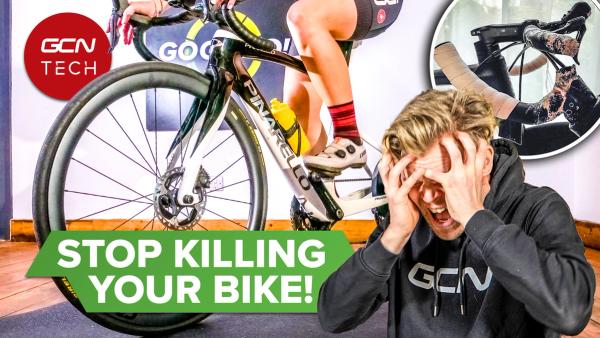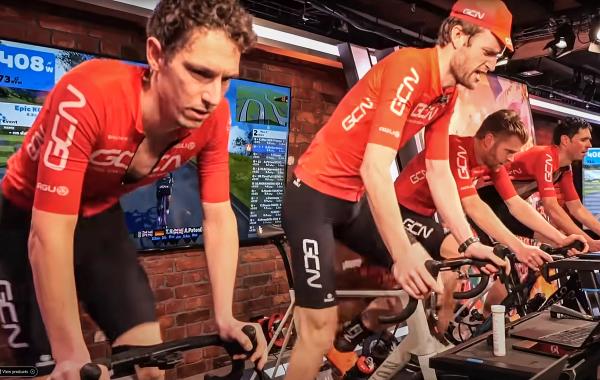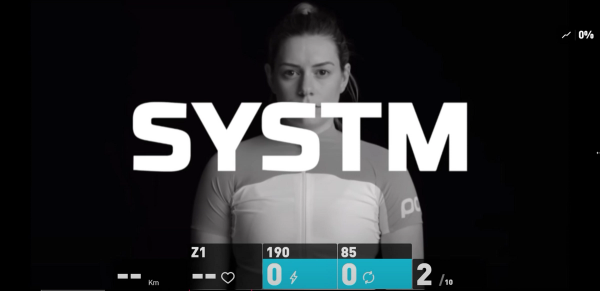Indoor cycling vs night riding: Which is better for winter training?
Keeping fit over winter is never easy, but which type of riding will give you the best returns on investment through the long cold nights?
Alex Hunt
Junior Tech Writer
For a lot of riders, October marks the change in seasons, with the warm afterglow of summer ebbing away, gradually being replaced by the cold and wet grasp of winter. This change brings with it long dark evenings and unfavourable conditions for cycling, which has in more recent years prompted a mass migration from outdoor to indoor riding.
Before we dive into the specifics of both indoor and outdoor riding, it is important to note that riding outdoors at night time is not for everyone. Riding alone at night time can be very intimidating as well as not all that accessible for some people, given the need for all the extra kit.
There will be tips on how to make night riding more comfortable, but your safety and enjoyment should always be the primary considerations when deciding how to ride.
Getting ready - time, equipment and clothing
For cyclists, the time it takes to get ready to ride really matters, as this needs to be factored into the time allocated to ride. Most of us lead busy lives and committing an extra 30 minutes to your ride while getting ready isn’t a luxury we can all afford.
If you have fully committed to a winter of indoor cycling and have space to leave your bike set up on the indoor trainer, getting ready to ride takes no longer than a typical summer ride would. The bike will be ready to go and the kit needed is as simple as a jersey, shorts and powering up a laptop to run your chosen training app.
For those that are going to venture out for a night ride, prep time is going to be more time consuming than in the summer.
Getting the right layers for the conditions, fiddling with overshoes, and getting lights charged and fitted all lead to a longer pre-ride routine. This is something to be aware of if you have a tight schedule as it could easily start eating into your precious ride time.
Making riding at night safer
Riding at night is undeniably more intimidating than riding in the daytime. Not only is there the simple fact of riding in the dark, with the limited visibility from you and others around you, but there's also the inclement weather that often accompanies rides at this time of year.
If you are new to riding outdoors at nighttime, investing in some good quality dependable lights is always advised, as they will build your confidence out on the road. Having a cheaper or less powerful back-up set is always advised, but we would consider it essential if your night rides take you into rural areas where there is no street lighting.

© GCN
Riding with a friend or in a group can be a way to make you feel safer while riding at night
Riding at night in a group or with a friend is another way to ease the nerves of riding in the dark. Finding a local group ride or chain gang allows the social aspect of cycling to remain, meaning if you do run in to any difficulty, either with a mechanical issue or faulty lights, you have a group around you to make sure that you get back home safely.
When planning a route for a night ride, you might find that it is best to use roads you might typically avoid in the day time. Using slightly larger roads that are lit or have some volume of traffic are a good choice for night riding. Those quiet country lanes that are so appealing in the summer can be hard to ride at night due to the lack of visibility and the narrow twisty nature of the lanes. Opting for a wider, well-used route will give you the benefit of street lighting as well as the chance of being able to get help if you run into any unfortunate issues.
Finally, something that we would encourage you to do on any solo ride – whether that be at night or in the day – is to share your intended route and live location with a loved one. Knowing that someone has your back and will be checking in on you to make sure you get home safely is a nice confidence boost when heading out on your own.
Cost of set-up, kit, and accessories
The cost of indoor versus outdoor riding is not a cut-and-dry topic of conversation and it really depends on what you already own and how much you want to spend.
If you don’t have an indoor training set-up already, getting one of these ready for winter is no small investment. On the other hand, getting a winter riding wardrobe and a set of dependable lights can come with a hefty price tag too!
- Read more: Getting started with Zwift indoor training
Indoor training
For an immersive and interactive indoor training configuration, you are going to need a smart trainer that allows you to connect to a virtual training app, along with a training platform and, at the very least, a high powered fan.
Other inclusions to consider would be a laptop stand to have the screen and keyboard near to your whilst riding, plus other training aids that can simulate the natural motion of riding.
Night riding
Riding at night time comes with its own expense. If you are riding your debut winter season, a decent haul of winter riding kit is going to be costly but essential. Finding a good long-sleeve base layer, jersey, and jacket along with some thermal bib tights will make riding comfortable through the winter nights.
Most important is investing in a good pair of lights that will last for the intended duration of your ride. For road cycling, we would recommend a light that has at least 1000 lumens, with rural riders benefiting from a light with more output. Although these lights do not come cheap, they are ultimately your lifeline for night riding and are what allow you to see and to be seen. A good pair of lights can transform your perception of night riding from a nightmare to something highly enjoyable.
The pros and cons of indoor training
Benefits
Using a virtual riding platform like Zwift gives you access to a whole wealth of options for your training, from in-built training sessions and training plans to virtual racing. If you are motivated, indoor riding can give you a great training environment.
Functions such as ERG training, which holds you at a fixed output regardless of gear or cadence, can create a controlled environment ideal for simulating the demands of a target event.
Virtual racing might not quite have the same dynamics as racing on the open road, but one thing that does transfer over are the punchy efforts required to stay in the bunch. What's more, the competitive nature of virtual racing will have you digging deeper than you otherwise would on your own.
- Read more: Essential turbo training equipment

© GCN
Zwift racing can have you digging deeper than if you were to try and replicate the efforts on your own
Drawbacks
With indoor training, as immersive and realistic as it may feel on the screen, when it really counts and you are deep into the pain cave, you are ultimately pedalling in your house going nowhere. For a lot of us out there, this can be a real issue when it comes to motivation, there is no exhilaration from railing corners or pushing you and your bike up a steep gradient to take your mind off of the suffering.
Depending on your set-up as well, indoor training does take up a lot of space. If you live in a flat or share a house with others having the space for an indoor trainer set-up can be hard to come by. If you need to pack down and set it up before and after every ride the process will get tiresome long before spring takes over from winter.
The pros and cons of nighttime outdoor training
Benefits
As the saying goes, ‘there is nowhere to hide’ when riding outside. Choosing to train on a hilly course will have you digging deep regardless of motivation. Having to battle with the terrain and the inevitable headwinds will give you a great session, even if you aren’t feeling all that motivated.
Another byproduct of riding at night is it will sharpen your bike handling skills. Having less time to plan and react to things will sharpen your reaction times as will riding on less than ideal surfaces littered in leaves.
Drawbacks
Winter riding is known for one main thing and that is bad weather. It is unavoidable that a large portion of your rides will at least feature inclement conditions and there will be days altogether where outdoor riding just isn’t viable. Snow, ice and fog all make riding outside, especially at night time, a hard pass.
There is also the added issue that riding through winter will accelerate wear and tear on your bike, all the salt on the road and general wet and slimy grime will eat through chains and cassettes as well as wheel bearings and headsets. Winter is a tough season on your bike and it could lead to some expensive bike shop bills.

© GCN
Riding at night time through the winter will have you bike screaming for a clean after almost every ride
Conclusions
The answer that no one is going to like to hear, is that the best option is to have both options available. Riding outside definitely has its benefits and will keep your bike handling sharp ready for when the weather improves on the other side of winter. However there are some days where riding outside just isn’t what you need or want.
For those looking for an answer either side of the fence, the short answer is whichever method will have you training the most consistently through winter, and whichever you enjoy most. If you can only do one, then this should be your go to.
However, one more thing to consider is how much the kit to train with each method will cost you. If you are looking to start from scratch with either, then the costs are probably closer than you think, but if you already have some of the necessary kit then that will swing things in a certain favour.
Need more indoor cycling help or inspiration? GCN's ultimate guide to indoor cycling has you covered with advice and guides on everything from turbo training tech to workouts. Check it out here.
.jpg?rect=957,780,3097,3060&w=600&auto=format)











